Experiencing jaw pain after a tooth filling is a common concern, and it's crucial to understand the potential causes and seek appropriate treatment. This discomfort can range from mild soreness to severe, throbbing pain, significantly impacting your daily life. This comprehensive guide explores the reasons behind this pain, effective treatment options, and preventive measures to minimize future occurrences.
What Causes Jaw Pain After a Tooth Filling?
Several factors can contribute to jaw pain following a tooth filling procedure. The most common causes include:
- Inflammation: The filling process itself can cause minor inflammation in the surrounding gum tissue and jaw. This is usually temporary and resolves within a few days.
- Irritation of the Temporomandibular Joint (TMJ): The TMJ connects your jaw to your skull, and any stress or inflammation in this area can lead to pain radiating to the jaw. The procedure, especially if it involved extensive work, might inadvertently strain the TMJ.
- Infection: Although less common, a bacterial infection at the filling site or in the surrounding tissues can cause significant jaw pain. This is often accompanied by swelling and other signs of infection.
- High Filling: If the filling is placed too high, it can interfere with your bite, leading to jaw pain and discomfort. This misalignment puts pressure on the jaw joint.
- Sinus Infection: Pain in the upper jaw can sometimes be related to a sinus infection, especially if the tooth in question is located near the sinuses. While not directly caused by the filling, a pre-existing or concurrent sinus infection could exacerbate the pain.
- Trauma during Procedure: In rare cases, the procedure itself might have caused minor trauma to the jawbone or surrounding structures. This can lead to delayed-onset pain.
- Underlying Dental Problems: Pre-existing conditions like bruxism (teeth grinding) or temporomandibular joint (TMJ) disorders might be aggravated by the filling procedure, resulting in increased jaw pain.
How Long Does Jaw Pain After a Tooth Filling Last?
The duration of jaw pain varies depending on the underlying cause. Mild soreness due to inflammation typically subsides within a few days. However, if the pain is severe, persistent, or accompanied by other symptoms like swelling or fever, it could indicate a more serious issue requiring professional attention. You should consult your dentist if the pain persists for more than a week or worsens.
What to Do if You Have Jaw Pain After a Tooth Filling?
If you experience jaw pain after a tooth filling, here are some steps to take:
- Contact your dentist: This is the most crucial step. They can diagnose the cause of your pain and recommend appropriate treatment.
- Over-the-counter pain relievers: Ibuprofen or acetaminophen can help manage mild to moderate pain. Always follow the dosage instructions on the label.
- Cold compress: Applying a cold compress to the affected area can help reduce swelling and inflammation.
- Gentle jaw massage: Gently massaging the jaw muscles can help relieve tension. However, avoid applying excessive pressure.
- Avoid chewing on the affected side: This will reduce stress on the jaw joint and allow the area to heal.
- Soft foods diet: Stick to a diet of soft foods to minimize discomfort while chewing.
Can a Tooth Filling Cause TMJ Problems?
While a tooth filling itself doesn't directly cause TMJ disorders, a poorly placed filling, one that interferes with your bite, can exacerbate pre-existing TMJ problems or trigger symptoms in susceptible individuals. The resulting misalignment forces the jaw joint to work harder, leading to pain and discomfort.
What are the Symptoms of a Tooth Infection After a Filling?
Symptoms of a tooth infection after a filling can include:
- Severe, throbbing pain: This pain is often localized but can radiate to the jaw and other areas.
- Swelling: Noticeable swelling around the affected tooth and jaw.
- Fever: A high fever is a strong indicator of infection.
- Pus: Pus may be visible around the tooth or gum line.
- Sensitivity to hot and cold: Increased sensitivity to temperature changes.
How Can I Prevent Jaw Pain After a Tooth Filling?
Preventing jaw pain after a tooth filling involves selecting a competent dentist and following their post-procedure instructions carefully. Consider these tips:
- Choose an experienced dentist: Select a dentist with a strong reputation and proven experience in placing fillings.
- Follow post-operative instructions: Adhere carefully to your dentist’s recommendations for post-procedure care.
- Maintain good oral hygiene: Brush and floss regularly to maintain oral health and prevent infections.
- Address underlying dental issues: Treat any pre-existing dental problems, such as bruxism or TMJ disorders, before undergoing a filling procedure.
Disclaimer: This information is intended for educational purposes only and should not be considered medical advice. Always consult your dentist or other qualified healthcare professional for any health concerns or before making any decisions related to your health or treatment.
